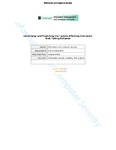Identifying and Predicting the Factors Affecting End-Users’ Risk-Taking Behavior
| dc.contributor.author | Clarke, Nathan | |
| dc.contributor.author | Alohali, M | |
| dc.contributor.author | Li, F | |
| dc.contributor.author | Furnell, Steven | |
| dc.date.accessioned | 2018-05-11T07:58:12Z | |
| dc.date.issued | 2018-06-01 | |
| dc.identifier.issn | 2056-4961 | |
| dc.identifier.issn | 2056-497X | |
| dc.identifier.uri | http://hdl.handle.net/10026.1/11497 | |
| dc.description.abstract |
<jats:sec><jats:title content-type="abstract-subheading">Purpose</jats:title> <jats:p>The end-user has frequently been identified as the weakest link; however, motivated by the fact that different users react differently to the same stimuli, identifying the reasons behind variations in security behavior and why certain users could be “at risk” more than others is a step toward protecting and defending users against security attacks. This paper aims to explore the effect of personality trait variations (through the Big Five Inventory [BFI]) on users’ risk level of their intended security behaviors. In addition, age, gender, service usage and information technology (IT) proficiency are analyzed to identify what role and impact they have on behavior.</jats:p> </jats:sec> <jats:sec><jats:title content-type="abstract-subheading">Design/methodology/approach</jats:title> <jats:p>The authors developed a quantitative-oriented survey that was implemented online. The bi-variate Pearson two-tailed correlation was used to analyze survey responses.</jats:p> </jats:sec> <jats:sec><jats:title content-type="abstract-subheading">Findings</jats:title> <jats:p>The results obtained by analyzing 538 survey responses suggest that personality traits do play a significant role in affecting users’ security behavior risk levels. Furthermore, the results suggest that BFI score of a trait has a significant effect as users’ online personality is linked to their offline personality, especially in the conscientiousness personality trait. Additionally, this effect was stronger when personality was correlated with the factors of IT proficiency, gender, age and online activity.</jats:p> </jats:sec> <jats:sec><jats:title content-type="abstract-subheading">Originality/value</jats:title> <jats:p>The contributions of this paper are two-fold. First, with the aid of a large population sample, end-users’ security practice is assessed from multiple domains, and relationships were found between end-users’ risk-taking behavior and nine user-centric factors. Second, based upon these findings, the predictive ability for these user-centric factors were evaluated to determine the level of risk a user is subject to from an individual behavior perspective. Of 28 behaviors, 11 were found to have a 60 per cent or greater predictive ability, with the highest classification of 92 per cent for several behaviors. This provides a basis for organizations to use behavioral intent alongside personality traits and demographics to understand and, therefore, manage the human aspects of risk.</jats:p> </jats:sec> | |
| dc.format.extent | 306-326 | |
| dc.language | en | |
| dc.language.iso | en | |
| dc.publisher | Emerald | |
| dc.rights | Attribution-NonCommercial 4.0 International | |
| dc.rights | Attribution-NonCommercial 4.0 International | |
| dc.rights | Attribution-NonCommercial 4.0 International | |
| dc.rights | Attribution-NonCommercial 4.0 International | |
| dc.rights | Attribution-NonCommercial 4.0 International | |
| dc.rights | Attribution-NonCommercial 4.0 International | |
| dc.rights.uri | http://creativecommons.org/licenses/by-nc/4.0/ | |
| dc.rights.uri | http://creativecommons.org/licenses/by-nc/4.0/ | |
| dc.rights.uri | http://creativecommons.org/licenses/by-nc/4.0/ | |
| dc.rights.uri | http://creativecommons.org/licenses/by-nc/4.0/ | |
| dc.rights.uri | http://creativecommons.org/licenses/by-nc/4.0/ | |
| dc.rights.uri | http://creativecommons.org/licenses/by-nc/4.0/ | |
| dc.subject | Behavioral and Social Science | |
| dc.subject | Basic Behavioral and Social Science | |
| dc.title | Identifying and Predicting the Factors Affecting End-Users’ Risk-Taking Behavior | |
| dc.type | journal-article | |
| dc.type | Article | |
| plymouth.issue | 3 | |
| plymouth.volume | 26 | |
| plymouth.publication-status | Published | |
| plymouth.journal | Information and Computer Security | |
| dc.identifier.doi | 10.1108/ICS-03-2018-0037 | |
| plymouth.organisational-group | /Plymouth | |
| plymouth.organisational-group | /Plymouth/Faculty of Science and Engineering | |
| plymouth.organisational-group | /Plymouth/Faculty of Science and Engineering/School of Engineering, Computing and Mathematics | |
| plymouth.organisational-group | /Plymouth/REF 2021 Researchers by UoA | |
| plymouth.organisational-group | /Plymouth/REF 2021 Researchers by UoA/UoA11 Computer Science and Informatics | |
| plymouth.organisational-group | /Plymouth/Users by role | |
| plymouth.organisational-group | /Plymouth/Users by role/Academics | |
| dcterms.dateAccepted | 2018-05-09 | |
| dc.rights.embargodate | 2019-2-12 | |
| dc.identifier.eissn | 2056-497X | |
| dc.rights.embargoperiod | 12 months | |
| rioxxterms.funder | Engineering and Physical Sciences Research Council | |
| rioxxterms.identifier.project | Identifying and Modelling Victim, Business, Regulatory and Malware Behaviours in a Changing Cyberthreat Landscape | |
| rioxxterms.versionofrecord | 10.1108/ICS-03-2018-0037 | |
| rioxxterms.licenseref.uri | http://creativecommons.org/licenses/by-nc/4.0/ | |
| rioxxterms.licenseref.startdate | 2018-06-01 | |
| rioxxterms.type | Journal Article/Review | |
| plymouth.funder | Identifying and Modelling Victim, Business, Regulatory and Malware Behaviours in a Changing Cyberthreat Landscape::Engineering and Physical Sciences Research Council |



